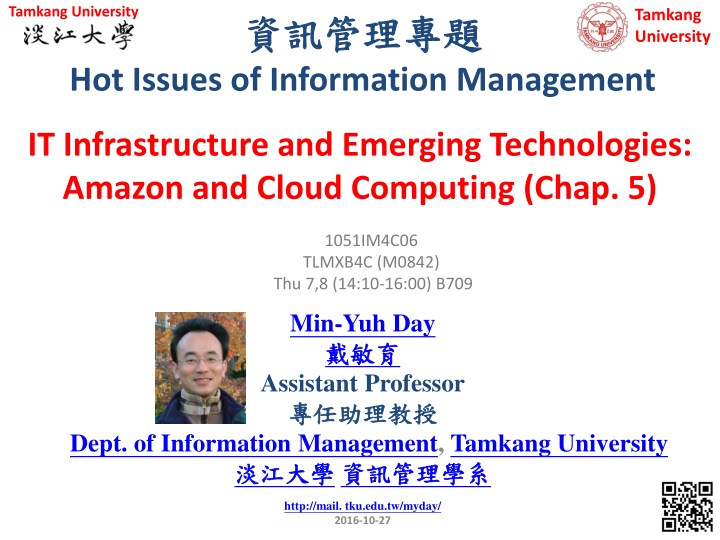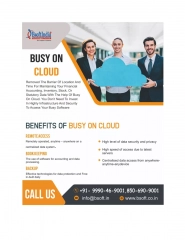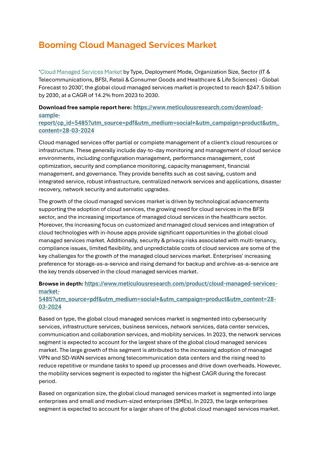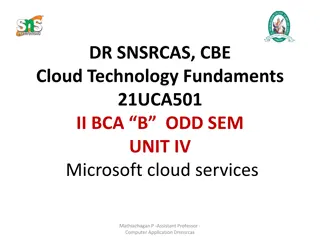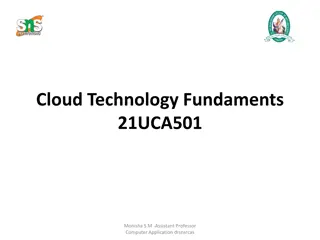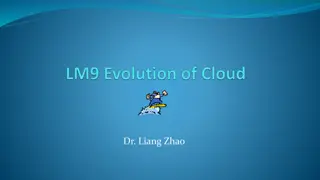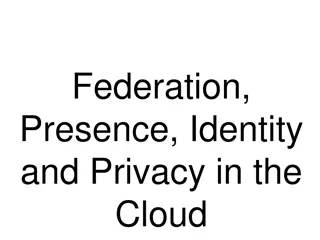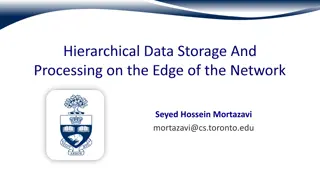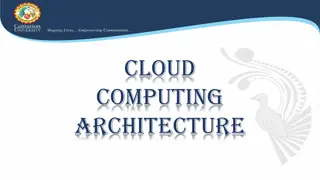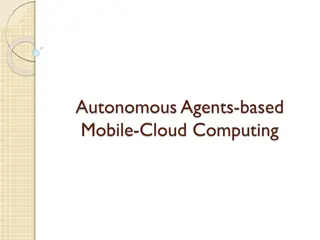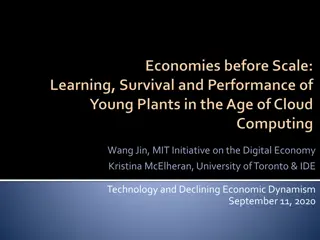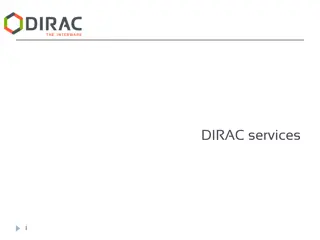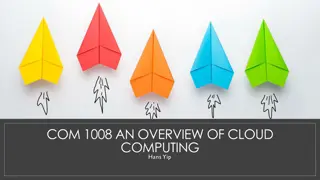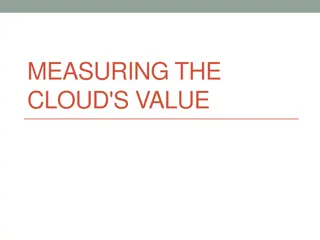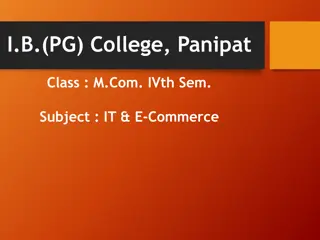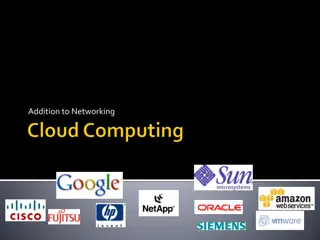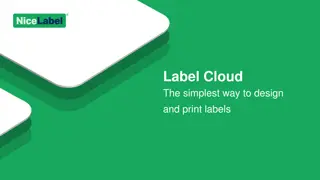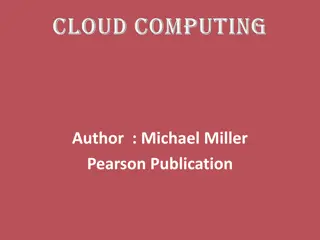Cloud Computing Services and Business Benefits
Exploring the advantages and disadvantages of cloud computing services, this case study on Amazon and Cloud Computing delves into key concepts such as capacity planning, scalability, and total cost of ownership. It questions the suitability of moving businesses to the cloud and identifies the types of businesses that could benefit most from this transition.
Download Presentation

Please find below an Image/Link to download the presentation.
The content on the website is provided AS IS for your information and personal use only. It may not be sold, licensed, or shared on other websites without obtaining consent from the author.If you encounter any issues during the download, it is possible that the publisher has removed the file from their server.
You are allowed to download the files provided on this website for personal or commercial use, subject to the condition that they are used lawfully. All files are the property of their respective owners.
The content on the website is provided AS IS for your information and personal use only. It may not be sold, licensed, or shared on other websites without obtaining consent from the author.
E N D
Presentation Transcript
Tamkang University Tamkang University Hot Issues of Information Management IT Infrastructure and Emerging Technologies: Amazon and Cloud Computing (Chap. 5) 1051IM4C06 TLMXB4C (M0842) Thu 7,8 (14:10-16:00) B709 Min-Yuh Day Assistant Professor Dept. of Information Management, Tamkang University http://mail. tku.edu.tw/myday/ 2016-10-27 1
(Syllabus) (Week) (Date) (Subject/Topics) 1 2016/09/15 ( ) (Mid-Autumn Festival)(Day off) 2 2016/09/22 Introduction to Case Study for Information Management Hot Topics 3 2016/09/29 Information Systems in Global Business: UPS (Chap. 1) (pp.53-54) 4 2016/10/06 Global E-Business and Collaboration: P&G (Chap. 2) (pp.84-85) 5 2016/10/13 Information Systems, Organization, and Strategy: Starbucks (Chap. 3) (pp.129-130) 6 2016/10/20 Ethical and Social Issues in Information Systems: Facebook (Chap. 4) (pp.188-190) 2
(Syllabus) (Week) (Date) (Subject/Topics) 7 2016/10/27 IT Infrastructure and Emerging Technologies: Amazon and Cloud Computing (Chap. 5) (pp. 234-236) 8 2016/11/03 Foundations of Business Intelligence: IBM and Big Data (Chap. 6) (pp.261-262) 9 2016/11/10 Midterm Report ( ) 10 2016/11/17 11 2016/11/24 Telecommunications, the Internet, and Wireless Technology: Google, Apple, and Microsoft (Chap. 7) (pp.318-320) 12 2016/12/01 Enterprise Applications: Summit and SAP (Chap. 9) (pp.396-398) 3
(Syllabus) Subject/Topics 13 2016/12/08 E-commerce: Zagat (Chap. 10) (pp.443-445) 14 2016/12/15 Enhancing Decision Making: Zynga (Chap. 12) (pp.512-514) 15 2016/12/22 Managing Projects: NYCAPS and CityTime (Chap. 14) (pp.586-588) 16 2016/12/29 Final Report I ( I) 17 2017/01/05 Final Report II ( II) 18 2017/01/12 4
Management Information Systems: Managing the Digital Firm 1 2 Organization, Management, and the Networked Enterprise Information Technology Infrastructure 3 4 Key System Applications for the Digital Age Building and Managing Systems 5 Source: Kenneth C. Laudon & Jane P. Laudon (2014), Management Information Systems: Managing the Digital Firm, Thirteenth Edition, Pearson.
Chap. 5 IT Infrastructure and Emerging Technologies: Amazon and Cloud Computing 6
Case Study: Amazon and Cloud Computing (Chap. 5) (pp. 234-236) Should Businesses Move to the Cloud? 1. What business benefits do cloud computing services provide? What problems do they solve? 2. What are the disadvantages of cloud computing? 3. How do the concepts of capacity planning, scalability, and TCO apply to this case? Apply these concepts both to Amazon and to subscribers of its services. 4. What kinds of businesses are most likely to benefit from using cloud computing? Why? 7 Source: Kenneth C. Laudon & Jane P. Laudon (2014), Management Information Systems: Managing the Digital Firm, Thirteenth Edition, Pearson.
Overview of Fundamental MIS Concepts Business Challenges Management Information System Business Solutions Organization Technology 8 Source: Kenneth C. Laudon & Jane P. Laudon (2014), Management Information Systems: Managing the Digital Firm, Thirteenth Edition, Pearson.
Business Model 2 8 6 4 1 Key Customer Relationships Activities Value Proposition Key Customer Segments Partners 3 7 Key Channels Resources 9 5 Cost Revenue Streams Structure 9 Source: Alexander Osterwalder & Yves Pigneur, Business Model Generation: A Handbook for Visionaries, Game Changers, and Challengers, Wiley, 2010.
IT Infrastructure Set of physical devices and software required to operate enterprise Set of firmwide services including: Computing platforms providing computing services Telecommunications services Data management services Application software services Physical facilities management services IT management, standards, education, research and development services Service platform perspective more accurate view of value of investments 10 Source: Kenneth C. Laudon & Jane P. Laudon (2014), Management Information Systems: Managing the Digital Firm, Thirteenth Edition, Pearson.
CONNECTION BETWEEN THE FIRM, IT INFRASTRUCTURE, AND BUSINESS CAPABILITIES 11 Source: Kenneth C. Laudon & Jane P. Laudon (2014), Management Information Systems: Managing the Digital Firm, Thirteenth Edition, Pearson.
STAGES IN IT INFRASTRUCTURE EVOLUTION 12 Source: Kenneth C. Laudon & Jane P. Laudon (2014), Management Information Systems: Managing the Digital Firm, Thirteenth Edition, Pearson.
STAGES IN IT INFRASTRUCTURE EVOLUTION 13 Source: Kenneth C. Laudon & Jane P. Laudon (2014), Management Information Systems: Managing the Digital Firm, Thirteenth Edition, Pearson.
A MULTITIERED CLIENT/SERVER NETWORK (N-TIER) 14 Source: Kenneth C. Laudon & Jane P. Laudon (2014), Management Information Systems: Managing the Digital Firm, Thirteenth Edition, Pearson.
MOORES LAW AND MICROPROCESSOR PERFORMANCE 15 Source: Kenneth C. Laudon & Jane P. Laudon (2014), Management Information Systems: Managing the Digital Firm, Thirteenth Edition, Pearson.
FALLING COST OF CHIPS 16 Source: Kenneth C. Laudon & Jane P. Laudon (2014), Management Information Systems: Managing the Digital Firm, Thirteenth Edition, Pearson.
EXAMPLES OF NANOTUBES 17 Source: Kenneth C. Laudon & Jane P. Laudon (2014), Management Information Systems: Managing the Digital Firm, Thirteenth Edition, Pearson.
THE COST OF STORING DATA DECLINES EXPONENTIALLY 1950 2012 18 Source: Kenneth C. Laudon & Jane P. Laudon (2014), Management Information Systems: Managing the Digital Firm, Thirteenth Edition, Pearson.
EXPONENTIAL DECLINES IN INTERNET COMMUNICATIONS COSTS 19 Source: Kenneth C. Laudon & Jane P. Laudon (2014), Management Information Systems: Managing the Digital Firm, Thirteenth Edition, Pearson.
IT Infrastructure has seven main components 1. Computer hardware platforms 2. Operating system platforms 3. Enterprise software applications 4. Data management and storage 5. Networking/telecommunications platforms 6. Internet platforms 7. Consulting system integration services 20 Source: Kenneth C. Laudon & Jane P. Laudon (2014), Management Information Systems: Managing the Digital Firm, Thirteenth Edition, Pearson.
THE IT INFRASTRUCTURE ECOSYSTEM 21 Source: Kenneth C. Laudon & Jane P. Laudon (2014), Management Information Systems: Managing the Digital Firm, Thirteenth Edition, Pearson.
Contemporary Hardware Platform Trends The Mobile Digital Platform Consumerization of IT and BYOD Grid computing Virtualization Cloud Computing Green Computing High-Performance and Power-Saving Processors Autonomic Computing 22 Source: Kenneth C. Laudon & Jane P. Laudon (2014), Management Information Systems: Managing the Digital Firm, Thirteenth Edition, Pearson.
Cloud computing On-demand (utility) computing services obtained over network Infrastructure as a service (IaaS) Platform as a service (PaaS) Software as a service (SaaS) Cloud can be public or private Allows companies to minimize IT investments Drawbacks: Concerns of security, reliability Hybrid cloud computing model 23 Source: Kenneth C. Laudon & Jane P. Laudon (2014), Management Information Systems: Managing the Digital Firm, Thirteenth Edition, Pearson.
CLOUD COMPUTING PLATFORM 24 Source: Kenneth C. Laudon & Jane P. Laudon (2014), Management Information Systems: Managing the Digital Firm, Thirteenth Edition, Pearson.
Contemporary Software Platform Trends Open Source Software Linux Software for the Web Java HTML and HTML5 Web Services Service-Oriented Architecture (SOA) Software Outsourcing Cloud Services 25 Source: Kenneth C. Laudon & Jane P. Laudon (2014), Management Information Systems: Managing the Digital Firm, Thirteenth Edition, Pearson.
HOW DOLLAR RENT A CAR USES WEB SERVICES 26 Source: Kenneth C. Laudon & Jane P. Laudon (2014), Management Information Systems: Managing the Digital Firm, Thirteenth Edition, Pearson.
CHANGING SOURCES OF FIRM SOFTWARE 27 Source: Kenneth C. Laudon & Jane P. Laudon (2014), Management Information Systems: Managing the Digital Firm, Thirteenth Edition, Pearson.
Software outsourcing and cloud services Three external sources for software: 1. Software packages and enterprise software 2. Software outsourcing Contracting outside firms to develop software 3. Cloud-based software services Software as a service (SaaS) Accessed with Web browser over Internet Service Level Agreements (SLAs): formal agreement with service providers 28 Source: Kenneth C. Laudon & Jane P. Laudon (2014), Management Information Systems: Managing the Digital Firm, Thirteenth Edition, Pearson.
Software outsourcing and cloud services Mashups Combinations of two or more online applications, such as combining mapping software (Google Maps) with local content Apps Small pieces of software that run on the Internet, on your computer, or on your cell phone iPhone, Android Generally delivered over the Internet 29 Source: Kenneth C. Laudon & Jane P. Laudon (2014), Management Information Systems: Managing the Digital Firm, Thirteenth Edition, Pearson.
Management Issues Dealing with platform and infrastructure change As firms shrink or grow, IT needs to be flexible and scalable Scalability: Ability to expand to serve larger numbers of users For mobile computing and cloud computing New policies and procedures for managing these new platforms Contractual agreements with firms running clouds and distributing software required 30 Source: Kenneth C. Laudon & Jane P. Laudon (2014), Management Information Systems: Managing the Digital Firm, Thirteenth Edition, Pearson.
Management Issues Management and governance Who controls IT infrastructure? How should IT department be organized? Centralized Central IT department makes decisions Decentralized Business unit IT departments make own decisions How are costs allocated between divisions, departments? 31 Source: Kenneth C. Laudon & Jane P. Laudon (2014), Management Information Systems: Managing the Digital Firm, Thirteenth Edition, Pearson.
Management Issues Making wise infrastructure investments Amount to spend on IT is complex question Rent vs. buy, outsourcing Total cost of ownership (TCO) model Analyzes direct and indirect costs Hardware, software account for only about 20% of TCO Other costs: Installation, training, support, maintenance, infrastructure, downtime, space and energy TCO can be reduced through use of cloud services, greater centralization and standardization of hardware and software resources 32 Source: Kenneth C. Laudon & Jane P. Laudon (2014), Management Information Systems: Managing the Digital Firm, Thirteenth Edition, Pearson.
COMPETITIVE FORCES MODEL FOR IT INFRASTRUCTURE 33 Source: Kenneth C. Laudon & Jane P. Laudon (2014), Management Information Systems: Managing the Digital Firm, Thirteenth Edition, Pearson.
Competitive forces model for IT infrastructure investment 1. Market demand for firm s services 2. Firm s business strategy 3. Firm s IT strategy, infrastructure, and cost 4. Information technology assessment 5. Competitor firm services 6. Competitor firm IT infrastructure investments 34 Source: Kenneth C. Laudon & Jane P. Laudon (2014), Management Information Systems: Managing the Digital Firm, Thirteenth Edition, Pearson.
Case Study: IBM and Big Data (Chap. 6) (pp. 261-262) Interactive Session: Technology: Big Data, Big Rewards 1. Describe the kinds of big data collected by the organizations described in this case. 2. List and describe the business intelligence technologies described in this case. 3. Why did the companies described in this case need to maintain and analyze big data? What business benefits did they obtain? 4. Identify three decisions that were improved by using big data. 5. What kinds of organizations are most likely to need big data management and analytical tools? Why? 35 Source: Kenneth C. Laudon & Jane P. Laudon (2014), Management Information Systems: Managing the Digital Firm, Thirteenth Edition, Pearson.
(Hot Issues of Information Management) 1. 2. 3. 4. 7,8 (14:10-16:00) B709 36
References Kenneth C. Laudon & Jane P. Laudon (2014), Management Information Systems: Managing the Digital Firm, Thirteenth Edition, Pearson. Kenneth C. Laudon & Jane P. Laudon (2014) 13 37
